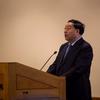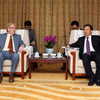Experience at world’s largest utility company informs call for nations to share energy... Read more about Global Power for Global Powers
Human-induced climate change will increase surface temperatures globally over the next several decades. Climate models project that global mean surface temperature could increase by over 2˚C by 2050 relative to the preindustrial period, with even greater changes at the regional level. These temperature changes have clear and pertinent implications for extremes, and consequentially, heat-induced health issues for people living in particularly hot climates. Here, we study future projections in the demand for AC globally in the 2050s associated with extreme heat events. To do this, we employ an ensemble of CMIP6 models under high and low emissions scenarios. We find that the increasing frequency of extreme temperatures will cause a significant portion of the global population to be exposed to conditions that require cooling. This issue will be especially pervasive in poor countries such as India and Indonesia, which at present lack the AC units required to handle rapidly growing populations and increased frequencies of extreme temperatures. The electricity needed for cooling in these countries could reach as high as 75% of the current total annual electricity demand, which could place serious strain on the electricity grid infrastructure during peak cooling hours. We conclude that demand for cooling in the future will pose a significant challenge for poorer countries whose people will require AC units to handle extreme temperatures. In some countries, the grid infrastructure is insufficient at present to meet projected AC demands, and this need must be considered in future power systems planning.





